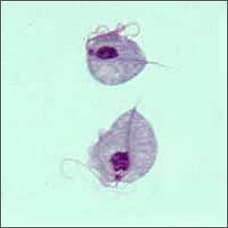Trichomoniasis – CDC Basic Fact Sheet

Trichomoniasis a common, treatable, sexually transmitted disease (STD). Most people who have trichomoniasis do not have any symptoms. This fact sheet answers general questions about trichomoniasis.

Two Trichomonas vaginalis parasites, magnified (seen under a microscope)
What is trichomoniasis?
Trichomoniasis (or “trich”) is a very common STD caused by infection with Trichomonas vaginalis (a protozoan parasite). Although symptoms vary, most people who have trich cannot tell they have it.
How common is trichomoniasis?
In the United States, CDC estimates that there were more than two million trichomoniasis infections in 2018. However, only about 30% develop any symptoms of trich. Infection is more common in women than in men. Older women are more likely than younger women to have the infection.
How is trichomoniasis spread?
Sexually active people can get trich by having sex without a condom with a partner who has trich.
In women, the infection is most commonly found in the lower genital tract (vulva, vagina, cervix, or urethra). In men, the infection is most commonly found inside the penis (urethra). During sex, the parasite usually spreads from a penis to a vagina, or from a vagina to a penis. It can also spread from a vagina to another vagina.
It is not common for the parasite to infect other body parts, like the hands, mouth, or anus. It is unclear why some people with the infection get symptoms while others do not. It probably depends on factors like a person’s age and overall health. People with trich can pass the infection to others, even if they do not have symptoms.
What are the signs and symptoms of trichomoniasis?
About 70% of people with the infection do not have any signs or symptoms. When trich does cause symptoms, they can range from mild irritation to severe inflammation. Some people get symptoms within 5 to 28 days after getting the infection. Others do not develop symptoms until much later. Symptoms can come and go.
Men with trich may notice:
- Itching or irritation inside the penis;
- Burning after peeing or ejaculating; and
- Discharge from the penis.
Women with trich may notice:
- Itching, burning, redness or soreness of the genitals;
- Discomfort when peeing; and
- A clear, white, yellowish, or greenish vaginal discharge (i.e., thin discharge or increased volume) with a fishy smell.
Having trich can make sex feel unpleasant. Without treatment, the infection can last for months or even years.
What are the complications of trichomoniasis?
Trich can increase the risk of getting or spreading other sexually transmitted infections. For example, trich can cause genital inflammation, making it easier to get HIV, or pass it to a sex partner.
How does trichomoniasis affect a pregnant person and her baby?
Pregnant people with trich are more likely to have their babies early. Also, their babies are more likely to have a low birth weight (less than 5.5 pounds).
How do healthcare providers diagnose trich?
It is not possible to diagnose trich based on symptoms alone. Your healthcare provider can examine you and a laboratory test will confirm the diagnosis.
What is the treatment for trichomoniasis?
Trich is the most common curable STD. A healthcare provider can treat the infection with medication (pills) taken by mouth. This treatment is also safe for pregnant people.
If you receive and complete treatment for trich, you can still get it again. Reinfection occurs in about 1 in 5 people within 3 months after receiving treatment. This can happen if you have sex without a condom with a person who has trich. To avoid reinfection, your sex partners should receive treatment at the same time.
You should not have sex again until you and your sex partner(s) complete treatment. You should receive testing again about three months after your treatment, even if your sex partner(s) received treatment.
How can I prevent trichomoniasis?
The only way to avoid STDs is to not have vaginal, anal, or oral sex.
If you are sexually active, you can do the following things to lower your chances of getting trich:
- Being in a long-term mutually monogamous relationship with a partner who has been tested and does not have trich.
- Using condoms the right way every time you have sex.
Also, talk about the potential risk of STDs before having sex with a new partner. This can help inform the choices you are comfortable taking with your sex life.
If you are sexually active, have an honest and open talk with your healthcare provider. Ask them if you should get tested for trich or other STDs.
Sources
Workowski, KA, Bachmann, LH, Chang, PA, et. al. Sexually Transmitted Infections Treatment Guidelines, 2021. MMWR Recomm Rep 2021; 70(No. 4): 1-187.
Kreisel KM, Spicknall IH, Gargano JW, Lewis FM, Lewis RM, Markowitz LE, Roberts H, Satcher Johnson A, Song R, St. Cyr SB, Weston EJ, Torrone EA, Weinstock HS. Sexually transmitted infections among US women and men: Prevalence and incidence estimates, 2018. Sex Transm Dis 2021; in press.
Peterman TA, Tian LH, Metcalf CA, Satterwhite CL, Malotte CK, DeAugustine N, Paul SM, Cross H, Rietmeijer CA, Douglas JM Jr; RESPECT-2 Study Group. High incidence of new sexually transmitted infections in the year following a sexually transmitted infection: a case for rescreening. Ann Intern Med. 2006 Oct 17;145(8):564-72.
Hobbs M, Seña EC, Swygard H, Schwebke J. Trichomonas vaginalis and Trichomoniasis. In: KK Holmes, PF Sparling, WE Stamm, P Piot, JN Wasserheit, L Corey, MS Cohen, DH Watts (editors). Sexually Transmitted Diseases, 4th edition. New York: McGraw-Hill, 2008, 771-793.
You can add this content to your website by syndicating.
Need Help Printing this Page?
Consider adjusting the scale or “shrink to fit” in your browser settings, or consult the printing instructions applicable to your browser. Alternatively, consider using the STD facts brochures or ordering materials through CDC-INFO on Demand (please note: stock is limited).
Chromeexternal icon | Safariexternal icon | Edgeexternal icon | Firefoxexternal icon | IEexternal icon
Additional Information
CDC-INFO
In English, en Español